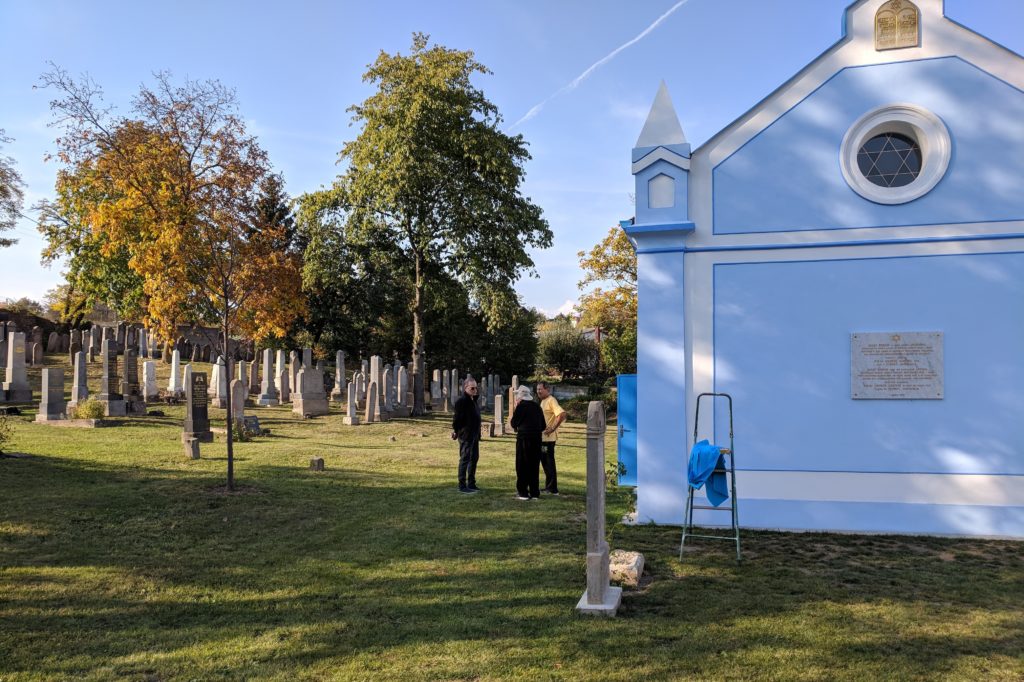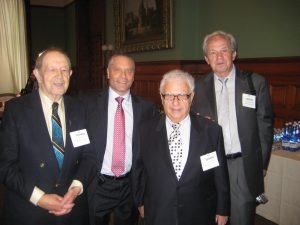Yehuda Danzig had warned his two sons, Ian and Mark, that there wouldn’t be much of a Jewish presence when they visited his hometown of Zlaté Moravce, Slovakia, on Oct. 9. The last time Danzig, 85, had visited, about 20 years prior, even the old Jewish cemetery was in a state of total disrepair.
So imagine Danzig’s surprise when he found the cemetery intact and the chapel repaired and painted a pleasing shade of powder blue.

Unbeknownst to Danzig and his sons at the time of their trip, a 90-year-old Australian man named Georg Gertler, whose hometown was the neighbouring village of Topolcianky, had donated money to repair the Jewish cemetery in Zlaté Moravce in appreciation of a family from the town that had hidden him during the Holocaust.
The Danzigs were also unaware that they had returned to the town the day before the official dedication ceremony for the restored cemetery and chapel.
Zlaté Moravce had had a Jewish community of around 1,300 before the Holocaust, comprising roughly 10 per cent of its total population. Yet, many years later, the town’s only living trace of them – prior to the cemetery restoration – was a still-functioning matzah factory.
As the lone Jew from Zlaté Moravce in attendance, the eldest Danzig was made an official representative of the town’s former Jewish population.
“They welcomed us with open arms and it was fantastic, and they remembered the whole Jewish community better than I did. They were talking about all kinds of Jewish families that I didn’t remember,” said Danzig. “And then they had nothing but good things to say.”
As part of the ceremonies, a choir sang Hebrew songs, including Shema and Yerushalayim Shel Zahav. At a celebration that night, a klezmer band from the country’s capital, Bratislava, performed.
“We didn’t even know these events were scheduled,” said Ian Danzig. “We got dragged into (a) downtown city hall building….. We didn’t know what was going on. Then we get dragged into this formal room and seated in the first row, completely unaware that there was this formal ceremony about to happen. And they wouldn’t start until we were there.”
On the surface, it seems like an incredible, uplifting story – but it’s still a Holocaust story, only possible because Yehuda Danzig and his hundred or so family members were deported from their town, many of them exterminated by the Einsatzgruppen in the surrounding woods.
Zlaté Moravce is remembering its Jewish heritage for the first time in 70 years, but Danzig hasn’t ever forgotten it – can’t ever forget it.
“To me, it was very strange, because I felt like, ‘Where were these people between 1939 and 1945, when the 1,300 Jews that were living in the town were being deported?’ ” he said.
This marked the third time Danzig returned to his hometown since 1944, when he was sent to the Bergen-Belsen concentration camp, along with his stepmother and siblings. Aside from the return 20 years ago, he and his surviving family members also came back after they were liberated, trying to resume their old lives and find other surviving family.
But a non-Jewish family had taken residence in his home, and was using all of his family’s possessions. The family business had also been taken over. Danzig and his family weren’t wanted there, so they left.
As painful as the experience was for Danzig, he recognizes how educational the whole trip was for his two sons. Ian Danzig says he’s also appreciative of the cemetery restoration and experience, in spite of how hard it was for his father.
“Because it’s something my father lived through, he’s not going to look on it with any kind of joy. But for me, and I’m sure my brother, it’s a great thing that our family’s history in this town isn’t going to be lost,” he said.
READ: ANTHONY: ALL STUDENTS NEED TO LEARN ABOUT GENOCIDE
This isn’t the first time Yehuda Danzig has been the subject of a remarkable coincidence relating to his painful past. In 2015, he recognized a photo of himself in a Netflix documentary about the concentration camps.






